英语基本句型双宾语结构
- 格式:docx
- 大小:11.30 KB
- 文档页数:2
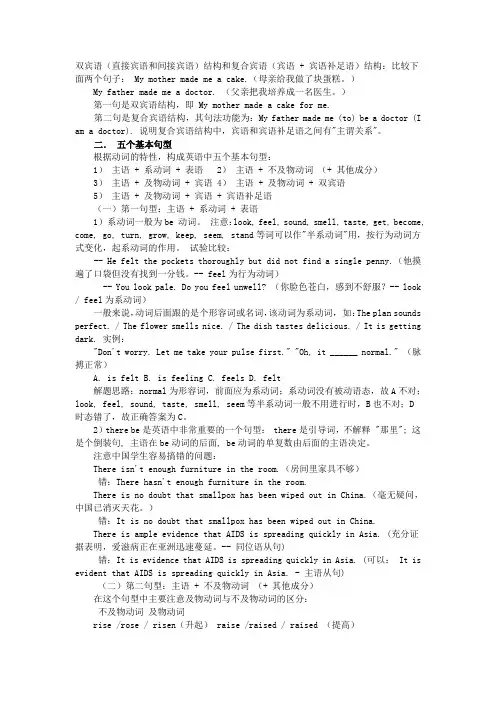
双宾语(直接宾语和间接宾语)结构和复合宾语(宾语 + 宾语补足语)结构:比较下面两个句子: My mother made me a cake.(母亲给我做了块蛋糕。
)My father made me a doctor. (父亲把我培养成一名医生。
)第一句是双宾语结构,即 My mother made a cake for me.第二句是复合宾语结构,其句法功能为:My father made me (to) be a doctor (I am a doctor). 说明复合宾语结构中,宾语和宾语补足语之间有"主谓关系"。
二.五个基本句型根据动词的特性,构成英语中五个基本句型:1)主语 + 系动词 + 表语2)主语 + 不及物动词(+ 其他成分)3)主语 + 及物动词 + 宾语 4)主语 + 及物动词 + 双宾语5)主语 + 及物动词 + 宾语 + 宾语补足语(一)第一句型:主语 + 系动词 + 表语1)系动词一般为be 动词。
注意:look, feel, sound, smell, taste, get, become, come, go, turn, grow, keep, seem, stand等词可以作"半系动词"用,按行为动词方式变化,起系动词的作用。
试验比较:-- He felt the pockets thoroughly but did not find a single penny.(他摸遍了口袋但没有找到一分钱。
-- feel为行为动词)-- You look pale. Do you feel unwell? (你脸色苍白,感到不舒服?-- look / feel为系动词)一般来说,动词后面跟的是个形容词或名词,该动词为系动词,如:The plan sounds perfect. / The flower smells nice. / The dish tastes delicious. / It is getting dark. 实例:"Don't worry. Let me take your pulse first." "Oh, it ______ normal." (脉搏正常)A. is feltB. is feelingC. feelsD. felt解题思路:normal为形容词,前面应为系动词;系动词没有被动语态,故A不对;look, feel, sound, taste, smell, seem等半系动词一般不用进行时,B也不对;D时态错了,故正确答案为C。
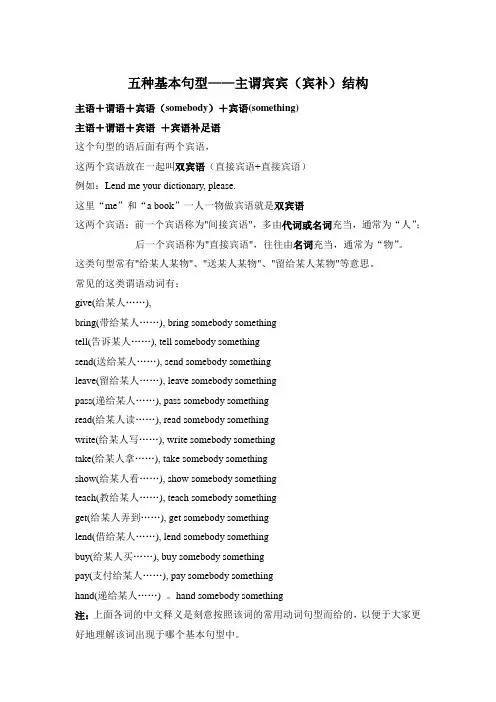
五种基本句型——主谓宾宾(宾补)结构主语+谓语+宾语(somebody)+宾语(something)主语+谓语+宾语+宾语补足语这个句型的语后面有两个宾语,这两个宾语放在一起叫双宾语(直接宾语+直接宾语)例如:Lend me your dictionary, please.这里“me”和“a book”一人一物做宾语就是双宾语这两个宾语:前一个宾语称为"间接宾语",多由代词或名词充当,通常为“人”;后一个宾语称为"直接宾语",往往由名词充当,通常为“物”。
这类句型常有"给某人某物"、"送某人某物"、"留给某人某物"等意思。
常见的这类谓语动词有:give(给某人……),bring(带给某人……), bring somebody somethingtell(告诉某人……), tell somebody somethingsend(送给某人……), send somebody somethingleave(留给某人……), leave somebody somethingpass(递给某人……), pass somebody somethingread(给某人读……), read somebody somethingwrite(给某人写……), write somebody somethingtake(给某人拿……), take somebody somethingshow(给某人看……), show somebody somethingteach(教给某人……), teach somebody somethingget(给某人弄到……), get somebody somethinglend(借给某人……), lend somebody somethingbuy(给某人买……), buy somebody somethingpay(支付给某人……), pay somebody somethinghand(递给某人……) 。


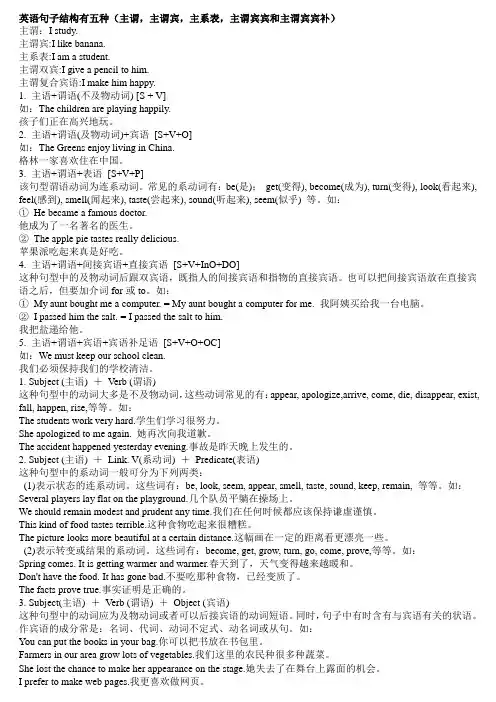
英语句子结构有五种(主谓,主谓宾,主系表,主谓宾宾和主谓宾宾补)主谓:I study.主谓宾:I like banana.主系表:I am a student.主谓双宾:I give a pencil to him.主谓复合宾语:I make him happy.1. 主语+谓语(不及物动词) [S + V]如:The children are playing happily.孩子们正在高兴地玩。
2. 主语+谓语(及物动词)+宾语[S+V+O]如:The Greens enjoy living in China.格林一家喜欢住在中国。
3. 主语+谓语+表语[S+V+P]该句型谓语动词为连系动词。
常见的系动词有:be(是);get(变得), become(成为), turn(变得), look(看起来), feel(感到), smell(闻起来), taste(尝起来), sound(听起来), seem(似乎) 等。
如:①He became a famous doctor.他成为了一名著名的医生。
②The apple pie tastes really delicious.苹果派吃起来真是好吃。
4. 主语+谓语+间接宾语+直接宾语[S+V+InO+DO]这种句型中的及物动词后跟双宾语,既指人的间接宾语和指物的直接宾语。
也可以把间接宾语放在直接宾语之后,但要加介词for或to。
如:①My aunt bought me a computer. = My aunt bought a computer for me. 我阿姨买给我一台电脑。
②I passed him the salt. = I passed the salt to him.我把盐递给他。
5. 主语+谓语+宾语+宾语补足语[S+V+O+OC]如:We must keep our school clean.我们必须保持我们的学校清洁。
1. Subject (主语) +Verb (谓语)这种句型中的动词大多是不及物动词,这些动词常见的有:appear, apologize,arrive, come, die, disappear, exist, fall, happen, rise,等等。
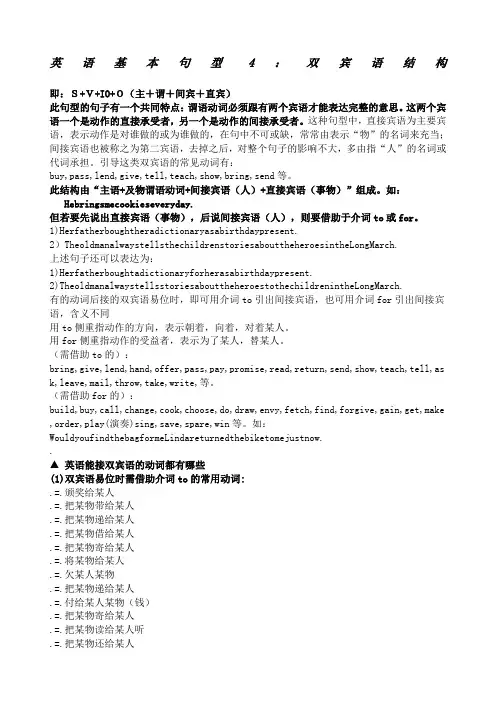
英语基本句型4:双宾语结构即:S+V+IO+O(主+谓+间宾+直宾)此句型的句子有一个共同特点:谓语动词必须跟有两个宾语才能表达完整的意思。
这两个宾语一个是动作的直接承受者,另一个是动作的间接承受者。
这种句型中,直接宾语为主要宾语,表示动作是对谁做的或为谁做的,在句中不可或缺,常常由表示“物”的名词来充当;间接宾语也被称之为第二宾语,去掉之后,对整个句子的影响不大,多由指“人”的名词或代词承担。
引导这类双宾语的常见动词有:buy,pass,lend,give,tell,teach,show,bring,send等。
此结构由“主语+及物谓语动词+间接宾语(人)+直接宾语(事物)”组成。
如:Hebringsmecookieseveryday.但若要先说出直接宾语(事物),后说间接宾语(人),则要借助于介词to或for。
1)Herfatherboughtheradictionaryasabirthdaypresent.2)TheoldmanalwaystellsthechildrenstoriesabouttheheroesintheLongMarch.上述句子还可以表达为:1)Herfatherboughtadictionaryforherasabirthdaypresent.2)TheoldmanalwaystellsstoriesabouttheheroestothechildrenintheLongMarch.有的动词后接的双宾语易位时,即可用介词to引出间接宾语,也可用介词for引出间接宾语,含义不同用to侧重指动作的方向,表示朝着,向着,对着某人。
用for侧重指动作的受益者,表示为了某人,替某人。
(需借助to的):bring,give,lend,hand,offer,pass,pay,promise,read,return,send,show,teach,tell,as k,leave,mail,throw,take,write,等。
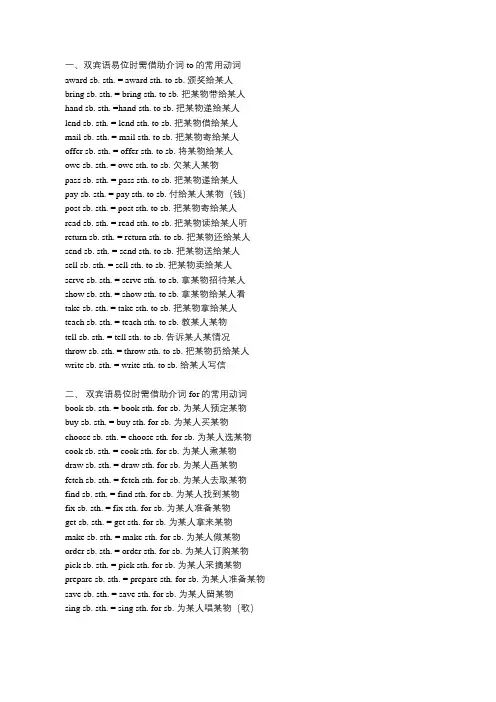
一、双宾语易位时需借助介词to的常用动词award sb. sth. = award sth. to sb. 颁奖给某人bring sb. sth. = bring sth. to sb. 把某物带给某人hand sb. sth. =hand sth. to sb. 把某物递给某人lend sb. sth. = lend sth. to sb. 把某物借给某人mail sb. sth. = mail sth. to sb. 把某物寄给某人offer sb. sth. = offer sth. to sb. 将某物给某人owe sb. sth. = owe sth. to sb. 欠某人某物pass sb. sth. = pass sth. to sb. 把某物递给某人pay sb. sth. = pay sth. to sb. 付给某人某物(钱)post sb. sth. = post sth. to sb. 把某物寄给某人read sb. sth. = read sth. to sb. 把某物读给某人听return sb. sth. = return sth. to sb. 把某物还给某人send sb. sth. = send sth. to sb. 把某物送给某人sell sb. sth. = sell sth. to sb. 把某物卖给某人serve sb. sth. = serve sth. to sb. 拿某物招待某人show sb. sth. = show sth. to sb. 拿某物给某人看take sb. sth. = take sth. to sb. 把某物拿给某人teach sb. sth. = teach sth. to sb. 教某人某物tell sb. sth. = tell sth. to sb. 告诉某人某情况throw sb. sth. = throw sth. to sb. 把某物扔给某人write sb. sth. = write sth. to sb. 给某人写信二、双宾语易位时需借助介词for的常用动词book sb. sth. = book sth. for sb. 为某人预定某物buy sb. sth. = buy sth. for sb. 为某人买某物choose sb. sth. = choose sth. for sb. 为某人选某物cook sb. sth. = cook sth. for sb. 为某人煮某物draw sb. sth. = draw sth. for sb. 为某人画某物fetch sb. sth. = fetch sth. for sb. 为某人去取某物find sb. sth. = find sth. for sb. 为某人找到某物fix sb. sth. = fix sth. for sb. 为某人准备某物get sb. sth. = get sth. for sb. 为某人拿来某物make sb. sth. = make sth. for sb. 为某人做某物order sb. sth. = order sth. for sb. 为某人订购某物pick sb. sth. = pick sth. for sb. 为某人采摘某物prepare sb. sth. = prepare sth. for sb. 为某人准备某物save sb. sth. = save sth. for sb. 为某人留某物sing sb. sth. = sing sth. for sb. 为某人唱某物(歌)spare sb. sth. = spare sth. for sb. 为某人让出某物steal sb. sth. = steal sth. for sb. 为某人偷某物三、特殊情况(1)有的动词后接的双宾语易位时,既可用介词to引出间接宾语,也可用介词for引出间接宾语,含义相同,如bring,play等:Bring me today’s paper. = Bring today’s paper to [for] me. 把今天的报纸拿给我。
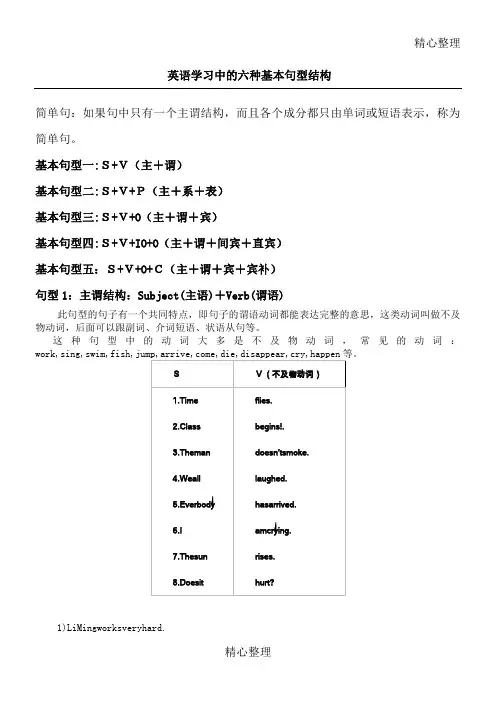
精心整理英语学习中的六种基本句型结构简单句:如果句中只有一个主谓结构,而且各个成分都只由单词或短语表示,称为简单句。
基本句型一:S+V(主+谓)基本句型二:S+V+P(主+系+表)句型1这词:1)LiMingworksveryhard.2)Thelittlegirlcriedevenharder.3)Theaccidenthappenedyesterdayafternoon.句型2:主系表结构:Subject(主语)+Link.V(系动词)+Predicate(表语)共同的特点:句子谓语动词都不能表达一个完整的意思,必须加上一个表明主语身份或状态的表语构成复合谓语,才能表达完整的意思。
这类动词叫做连系动词。
系动词分两类:be,look,feel,smell等属一类,表示情况;get,grow,become,turn等属另一类,表示变化。
be本身没有什么意义,只起连系主语和表语的作用。
其它系动词仍保持其部分词义。
这种句型主要用来表示主语的特点、身份等。
其系动词一般可分为下列三类:1)表示特征和存在状态的be,seem,feel,appear,look,smell,taste,soundThiskindoffoodtastesdelicious.共同特点是:谓语动词都具有实义,都是主语产生的动作,但不能表达完整的意思,必须跟有一个宾语,即动作的承受者,才能使意思完整。
这类动词叫做及物动词。
这种句型中的动词一般为及物动词。
其宾语通常由名词、代词、动词不定式、动名词或从句等来充当。
)+略。
这种句型中,直接宾语为主要宾语,在句中不可或缺,常常由表示“物”的名词来充当;间接宾语也被称之为第二宾语,去掉之后,对整个句子的影响不大,多由指“人”的名词或代词承担。
引导这类双宾语的常见动词有:buy,pass,lend,give,tell,teach,show,bring,send等。
此结构由主语+及物谓语动词+间接宾语(人)+直接宾语(事物)组成;但若要先说出直接宾语(事物),后说间接宾语(人),则要借助于介词to或for。
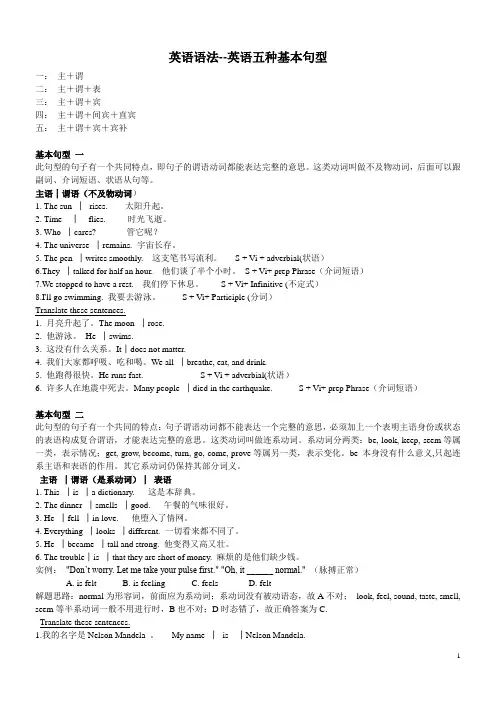
英语语法--英语五种基本句型一:主+谓二:主+谓+表三:主+谓+宾四:主+谓+间宾+直宾五:主+谓+宾+宾补基本句型一此句型的句子有一个共同特点,即句子的谓语动词都能表达完整的意思。
这类动词叫做不及物动词,后面可以跟副词、介词短语、状语从句等。
主语│谓语(不及物动词)1. The sun │rises. 太阳升起。
2. Time │flies. 时光飞逝。
3. Who │cares? 管它呢?4. The universe │remains. 宇宙长存。
5. The pen │writes smoothly. 这支笔书写流利。
S + Vi + adverbial(状语)6.They │talked for half an hour. 他们谈了半个小时。
S + Vi+ prep Phrase(介词短语)7.We stopped to have a rest. 我们停下休息。
S + Vi+ Infinitive (不定式)8.I'll go swimming. 我要去游泳。
S + Vi+ Participle (分词)Translate these sentences.1. 月亮升起了。
The moon │rose.2. 他游泳。
He │swims.3. 这没有什么关系。
It│does not matter.4. 我们大家都呼吸、吃和喝。
We all │breathe, eat, and drink.5. 他跑得很快。
He runs fast. S + Vi + adverbial(状语)6. 许多人在地震中死去。
Many people │died in the earthquake. S + Vi+ prep Phrase(介词短语)基本句型二此句型的句子有一个共同的特点:句子谓语动词都不能表达一个完整的意思,必须加上一个表明主语身份或状态的表语构成复合谓语,才能表达完整的意思。
这类动词叫做连系动词。
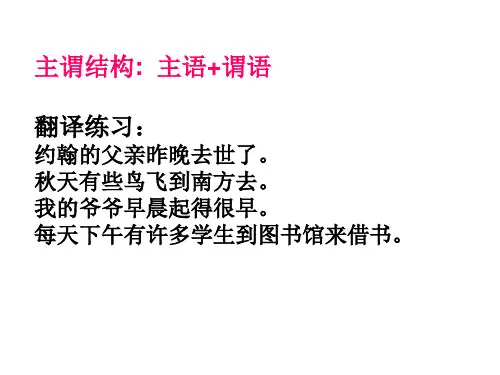
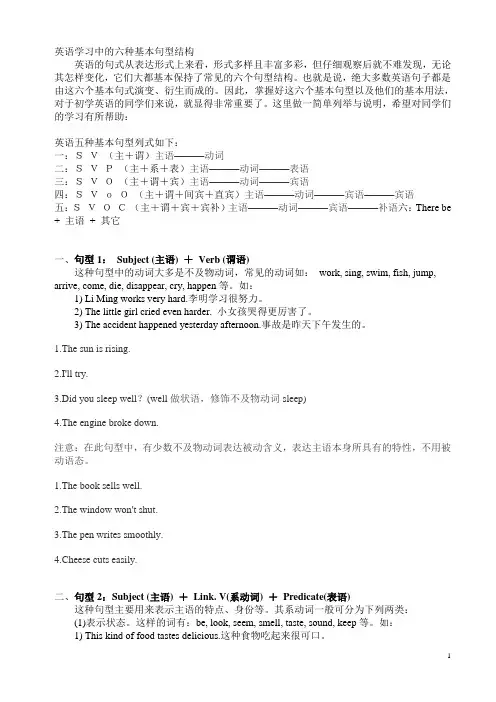
英语学习中的六种基本句型结构英语的句式从表达形式上来看,形式多样且丰富多彩,但仔细观察后就不难发现,无论其怎样变化,它们大都基本保持了常见的六个句型结构。
也就是说,绝大多数英语句子都是由这六个基本句式演变、衍生而成的。
因此,掌握好这六个基本句型以及他们的基本用法,对于初学英语的同学们来说,就显得非常重要了。
这里做一简单列举与说明,希望对同学们的学习有所帮助:英语五种基本句型列式如下:一:SV(主+谓)主语———动词二:SVP(主+系+表)主语———动词———表语三:SVO(主+谓+宾)主语———动词———宾语四:SVoO(主+谓+间宾+直宾)主语———动词———宾语———宾语五:SVOC(主+谓+宾+宾补)主语———动词———宾语———补语六:There be + 主语+ 其它一、句型1:Subject (主语) +Verb (谓语)这种句型中的动词大多是不及物动词,常见的动词如:work, sing, swim, fish, jump, arrive, come, die, disappear, cry, happen等。
如:1) Li Ming works very hard.李明学习很努力。
2) The little girl cried even harder. 小女孩哭得更厉害了。
3) The accident happened yesterday afternoon.事故是昨天下午发生的。
1.The sun is rising.2.I'll try.3.Did you sleep well?(well做状语,修饰不及物动词sleep)4.The engine broke down.注意:在此句型中,有少数不及物动词表达被动含义,表达主语本身所具有的特性,不用被动语态。
1.The book sells well.2.The window won't shut.3.The pen writes smoothly.4.Cheese cuts easily.二、句型2:Subject (主语) +Link. V(系动词) +Predicate(表语)这种句型主要用来表示主语的特点、身份等。
第四类基本句型—主谓双宾:主语+谓语+双宾语(直接宾语+ 间接宾语)i间接宾语放在前面’s evening paper?ii间接宾语放到后面1、间接宾语由to引导: your car?——handed the letter —gave her telephone number2 有的间接宾语由for引导:paper?/fetch the evening paper for me–sang a folk song for us -a delicious meal for us*3、直接宾语是从句our teacher told us please advise mehe taught me he asked meshow me tell metranslation exercise:1.递给我一杯水,杰克。
2.你能告诉我张教授家的地址吗? 3 能借我一点钱吗?4 把你知道的都告诉我。
5 他通知汤姆他的邮件已经到了。
6 妈妈答应小明做完作业后可以看电视。
7 学校去年奖励他一等奖学金。
(award) 8坐飞机省了我们很多时间。
9 这个故事让我想起我的童年。
第五类基本句型:主谓宾补:主语+谓语+宾语+宾语补语1.做补语all work and no play adull oy。
a rulemary.2 做补语trustworthy?free?rather boring。
3做补语i won’t letdown any way。
don't leave behind。
/alonewe found her in /out4不定式做补语to speak.happy。
to do?*不带to 的不定式(一些特殊动词要求) the mother helps her son do the homework. i help study english。
we can’t letgo on。
we had never sing like that.5介词短语做补语in order.in confusion.under control.6现在分词做补语(宾语和动词之间是主动关系)doing such a thing? watching him.thinking.篇二:语文句子结构主谓宾分析一.句子类型句子按照不同的标准,有不同的分类。
英语五种基本句型结构英语语中的5种基本句型结构一、句型Subject (语)+Verb(谓语)这种句型中的动词大多是不及物动词(Vi),所谓不及物动词,就是这种动词后不可以直接接宾语你见的动词如:work, sing, swim, fish, jump, arrive, come, die, disappear, cry, happen 等。
如:1) Li Ming works very hard夺明学习很努力2) The accident happened yesterday afternoon.事故是昨天下午发生的。
3 ) Spring is coming.4) We have lived in the city for ten years.二、句型2: Subject 主语+ Link. (系动词)+ Predicate 表语)这种句型要用来表示主语的特点、身份等其系动词般可分为下列两类:(1)表示状态这样的词有be, look, seem, smell, taste, sound, keep1) This kind of food tastes delicious这种食物吃起来很可口2) He looked worried Just now刚才他看上去有些焦急(2)表示变化这类系动词有become turn, get, grow, go1) Spring comes. It is getting warmer and warmer.春天到了,天气变得越来越暧和2) The tree has grown much taller than before .这棵树比以前长得高多了三、句型3: Subject 语)+ Verb (谓语)+ Object (宾语)这种句型中的动词股为及物动词,所谓及物动词(Vt),就是这种动词后可以直接接宾语,其宾语通常由名词、代词、动词不定式、动名词或从句等来充当,例:1) He took his bag and left (名词) 他拿若书包离开了.2) Li Lei always helps me when I have difficulties (代词)当我遇到困难时李雷总能给我帮助3) She plans to travel in the coming May Day. (不定式)她打算在即将到来的“五一”外出旅游。
五种基本句型__主谓宾宾(宾补)结构_实用练习加详细解析(总6页)--本页仅作预览文档封面,使用时请删除本页--五种基本句型——主谓宾宾(宾补)结构主语+谓语+宾语(somebody)+宾语(something)主语+谓语+宾语+宾语补足语这个句型的语后面有两个宾语,这两个宾语放在一起叫双宾语(直接宾语+直接宾语)例如:Lend me your dictionary, please.这里“me”和“a book”一人一物做宾语就是双宾语这两个宾语:前一个宾语称为"间接宾语",多由代词或名词充当,通常为“人”;后一个宾语称为"直接宾语",往往由名词充当,通常为“物”。
这类句型常有"给某人某物"、"送某人某物"、"留给某人某物"等意思。
常见的这类谓语动词有:give(给某人……),bring(带给某人……), bring somebody somethingtell(告诉某人……), tell somebody somethingsend(送给某人……), send somebody somethingleave(留给某人……), leave somebody somethingpass(递给某人……), pass somebody somethingread(给某人读……), read somebody somethingwrite(给某人写……), write somebody somethingtake(给某人拿……), take somebody somethingshow(给某人看……), show somebody somethingteach(教给某人……), teach somebody somethingget(给某人弄到……), get somebody somethinglend(借给某人……), lend somebody somethingbuy(给某人买……), buy somebody somethingpay(支付给某人……), pay somebody somethinghand(递给某人……) 。
英语语法五大基本句型英语语法五大基本句型英语句子是由主语、谓语动词、宾语、表语、状语、宾语补足语等成分组成。
以下是店铺整理的英语语法五大基本句型,我们一起看看吧!英语语法五大基本句型篇1一There be 句型1、解释:“……地方有……”;2、结构:There be + 主语 + 地点状语eg:There are some apples on the table.3、考点:主谓一致(1)be 后名词是单数名词或不可数名词,be 用 is 或者 was;后接可数名词复数则用 are 或were。
eg:There is an apple in the fridge.There is some milk in the fridge.There isn’t any / is no money in the box.There are many girls in the room.(2)如果 be 后面是几个并列名词作主语,be 的单复数和最靠近的名词保持一致——就近原则。
eg:There is a book and two pencils on the desk.There are two pencils and a book on the desk.二主系表1、结构:主语+系动词+表语eg:He is good.He is a good student.2、系动词:必须加上一个表明主语身份或状态的表语才能表达完整的意思,这类动词叫系动词。
常见系动词:(1)be 动词——is/am/are/was/were(2)感官动词——feel/look/sound/taste/smell(3)表转变动词——get/grow/become/goeg:感官动词主系表——It looks perfect. 它看上去真完美。
表转变动词主系表——The sky grew dark./ It became dirty.3、考点:系动词后面跟形容词eg:He looks at her happily.(happily 修饰 look at,look at 解释为看着,look 是实义动词)He looks happy when he sees her.(look 不及物,这里没有跟介词,单独行动,翻译/为“看上去”,是系动词,后跟形容词。
英语中几种基本的句子结构一、句型1:Subject (主语) +Verb (谓语)这种句型中的动词大多是不及物动词,所谓不及物动词,就是这种动词后不可以直接接宾语。
常见的动词如:work, sing, swim, fish, jump, arrive, come, die, disappear, cry, happen等。
如:1) Li Ming works very hard.李明学习很努力。
2) The accident happened yesterday afternoon.事故是昨天下午发生的。
3)Spring is coming.4) We have lived in the city for ten years.二、句型2:Subject (主语) +Link. V(系动词) +Predicate(表语)这种句型主要用来表示主语的特点、身份等。
其系动词一般可分为下列两类:(1)表示状态。
这样的词有:be, look, seem, smell, taste, sound, keep等。
如:1) This kind of food tastes delicious.这种食物吃起来很可口。
2) He looked worried just now.刚才他看上去有些焦急。
(2)表示变化。
这类系动词有:become, turn, get, grow, go等。
如:1) Spring comes. It is getting warmer and warmer.春天到了,天气变得越来越暖和。
2) The tree has grown much taller than before.这棵树比以前长得高多了。
三、句型3:Subject(主语) +Verb (谓语) +Object (宾语)这种句型中的动词一般为及物动词, 所谓及物动词,就是这种动词后可以直接接宾语,其宾语通常由名词、代词、动词不定式、动名词或从句等来充当。
英语学习中的六种基本句型结构简单句:如果句中只有一个主谓结构,而且各个成分都只由单词或短语表示,称为简单句。
句型1:主谓结构:Subject (主语) +Verb (谓语)这种句型中的动词大多是不及物动词,常见的动词:work, sing, swim, fish, jump, arrive, come, die, disappear, cry, happen等。
1) Li Ming works very hard.2) The little girl cried even harder.3) The accident happened yesterday afternoon.句型2:主系表结构:Subject (主语) +Link. V(系动词) +Predicate(表语)这种句型主要用来表示主语的特点、身份等。
其系动词一般可分为下列两类:1)表示特征和存在状态的be, seem, feel, appear, look, smell, taste, soundThis kind of food tastes delicious.2)表示状态延续的remain, stay, keep, continue, stand3)表示状态变化的become, get, turn, go, run, fall, come, growSpring comes. It is getting warmer and warmer.句型3:主谓宾结构:Subject(主语) +Verb (谓语) +Object (宾语)这种句型中的动词一般为及物动词。
其宾语通常由名词、代词、动词不定式、动名词或从句等来充当。
1) He took his bag and left.(名词)2) Li Lei always helps me when I have difficulties. (代词)3) She plans to travel in the coming May Day.(不定式)4) I don’t know what I should do next. (从句)句型4:S十V十间接宾语+直接宾语:Subject(主语)+Verb(谓语)+Indirect object(间接宾语)+Direct object (直接宾语)这种句型中,直接宾语为主要宾语,在句中不可或缺,常常由表示“物”的名词来充当;间接宾语也被称之为第二宾语,去掉之后,对整个句子的影响不大,多由指“人”的名词或代词承担。
英语基本句型4:双宾语结构
即:S+V+IO +O(主+谓+间宾+直宾)
此句型的句子有一个共同特点:谓语动词必须跟有两个宾语才能表达完整的意思。
这两个宾语一个是动作的直接承受者,另一个是动作的间接承受者。
这种句型中,直接宾语为主要宾语,表示动作是对谁做的或为谁做的,在句中不可或缺,常常由表示“物”的名词
来充当;间接宾语也被称之为第二宾语,去掉之后,对整个句子的影响不大,多由指“人”
的名词或代词承担。
引导这类双宾语的常见动词有:buy, pass, lend, give, tell, teach, show, bring, send等。
此结构由“主语+及物谓语动词+间接宾语(人)+直接宾语(事物)”组成。
如:He brings me cookies every day.
但若要先说出直接宾语(事物),后说间接宾语(人),则要借助于介词to或for。
1) Her father bought her a dictionary as a birthday present.
2)The old man always tells the children stories about the heroes in the Long March.
上述句子还可以表达为:
1)Her father bought a dictionary for her as a birthday present.
2)The old man always tells stories about the heroes to the children in the Long March.
有的动词后接的双宾语易位时,即可用介词to引出间接宾语,也可用介词for引出间接宾语,含义不同
用to侧重指动作的方向,表示朝着,向着,对着某人。
用for 侧重指动作的受益者,表示为了某人,替某人。
(需借助to的):bring, give, lend, hand, offer, pass, pay, promise, read, return, send, show, teach, tell, ask,leave,mail, throw, take, write,等。
(需借助for 的):build, buy, call, change, cook, choose, do, draw, envy, fetch,find, forgive,gain, get, make, order,play(演奏) sing, save, spare, win等。
如:
Would you find the bag for me? Linda returned the bike to me just now.
He brings cookies to me every day. She made a beautiful dress for me.
▲英语能接双宾语的动词都有哪些?
(1) 双宾语易位时需借助介词to的常用动词:
award sb. sth. = award sth. to sb. 颁奖给某人
bring sb. sth. = bring sth. to sb. 把某物带给某人
hand sb. sth. =hand sth. to sb. 把某物递给某人
lend sb. sth. = lend sth. to sb. 把某物借给某人
mail sb. sth. = mail sth. to sb. 把某物寄给某人
offer sb. sth. = offer sth. to sb. 将某物给某人
owe sb. sth. = owe sth. to sb. 欠某人某物
pass sb. sth. = pass sth. to sb. 把某物递给某人
pay sb. sth. = pay sth. to sb. 付给某人某物(钱)
post sb. sth. = post sth. to sb. 把某物寄给某人
read sb. sth. = read sth. to sb. 把某物读给某人听
return sb. sth. = return sth. to sb. 把某物还给某人
send sb. sth. = send sth. to sb. 把某物送给某人
sell sb. sth. = sell sth. to sb. 把某物卖给某人
serve sb. sth. = serve sth. to sb. 拿某物招待某人
show sb. sth. = show sth. to sb. 拿某物给某人看
take sb. sth. = take sth. to sb. 把某物拿给某人
teach sb. sth. = teach sth. to sb. 教某人某物
tell sb. sth. = tell sth. to sb. 告诉某人某情况
throw sb. sth. = throw sth. to sb. 把某物扔给某人
write sb. sth. = write sth. to sb. 给某人写信
(2) 双宾语易位时需借助介词for的常用动词:
book sb. sth. = book sth. for sb. 为某人预定某物
buy sb. sth. = buy sth. for sb. 为某人买某物
choose sb. sth. = choose sth. for sb. 为某人选某物
cook sb. sth. = cook sth. for sb. 为某人煮某物
draw sb. sth. = draw sth. for sb. 为某人画某物
fetch sb. sth. = fetch sth. for sb. 为某人去取某物
find sb. sth. = find sth. for sb. 为某人找到某物
fix sb. sth. = fix sth. for sb. 为某人准备某物
get sb. sth. = get sth. for sb. 为某人拿来某物
make sb. sth. = make sth. for sb. 为某人做某物
order sb. sth. = order sth. for sb. 为某人订购某物
pick sb. sth. = pick sth. for sb. 为某人采摘某物
prepare sb. sth. = prepare sth. for sb. 为某人准备某物
save sb. sth. = save sth. for sb. 为某人留某物
sing sb. sth. = sing sth. for sb. 为某人唱某物(歌)
spare sb. sth. = spare sth. for sb. 为某人让出某物
steal sb. sth. = steal sth. for sb. 为某人偷某物
巩固练习:
1.Johnson 先生去年教我们德语。
________________________________________ 2.奶奶昨晚给我们讲了一个有趣的故事。
_________________________________ 3.请把那本字典递给我好吗?__________________________________________ 4.他把车票给列车员看。
______________________________________________ 5.我替你叫辆出租汽车好吗?___________________________________________ 6.新式机器将会为你节省许多劳动。
____________________________________ 7.他用他的第一个月工资给他妈妈买了一件毛衣。
_____________________________________________________________________。